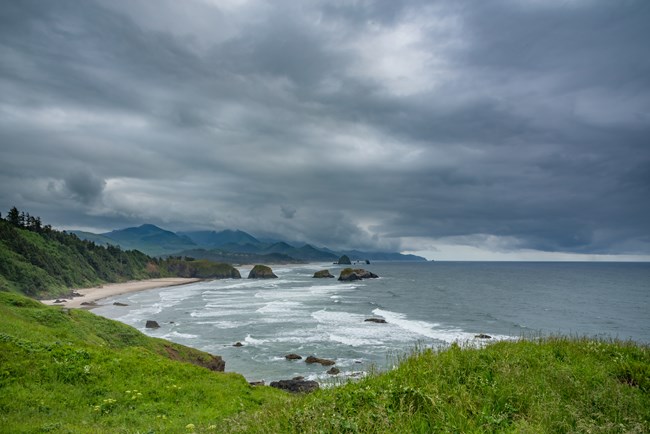Last updated: January 14, 2025
Article
Cannon Beach

Creative Commons License
On January 6, 1806, Clark and some expedition members set out to investigate reports of a beached whale, arriving at this site two days later. Clark remarked in his journal on the beauty of the coast and the great sea stack rocks out in the ocean. By the time they reached the whale, local Indigenous people had already harvested everything but the skeleton.44
Rising sea levels and increasing storms are causing greater rates of erosion along the Oregon coastline. Erosion threatens Indigenous cultural and archaeological sites all along the Pacific Coast. These places, such as nearby Ecola Creek, include shell middens, fishing structures, petroglyphs, and village sites. A study found the average erosion rate at Cannon Beach to be about 1.6 feet per year since 1967. Even a slight sea level rise greatly increases the risk of flooding events. Adaptations along the coast will be necessary to mitigate the risk of flooding and erosion.45
Citations:
44 NPS, “Ecola Creek/Cannon Beach,” Pittsburgh to the Pacific: High Potential Historic Sites of the Lewis and Clark National Historical Trail, 2022, 93, https://www.nps.gov/lecl/getinvolved/upload/2022_LCNHT_HPHS_Report_508compliantUPDATE-2.pdf; William Clark, January 8, 1806 entry, in Gary E. Moulton, Journals of the Lewis and Clark Expedition, https://lewisandclarkjournals.unl.edu/item/lc.jrn.1806-01-08.
45 Oregon Climate Change Research Institute, Fifth Oregon Climate Assessment (Corvalis: Oregon State University, 2021), 76–78, https://www.oregon.gov/highered/public-engagement/Documents/Commission/FullCommission/2021/Feb%2011/4.2%20Public%20Comment-Erica%20Fleishman%20OCAR5.pdf; Jeffrey A. Weber, et al., Regional Framework for Climate Adaptation: Clatsop and Tillamook Counties (Corvallis: Oregon Sea Grant, 2015), 51, https://pnwcirc.org/sites/pnwcirc.org/files/regional_framework_adapt_clat_till.pdf; Madonna L. Moss and Jon Erlandson, “Native American Archaeological Sites of the Oregon Coast: the Historic Context for the Nomination to the National Register of Historic Places,” in Dunes, Headlands, Estuaries, and Rivers: Current Archaeological Research on the Oregon Coast, edited by Guy L. Tasa and Brian L. O’Neill (Association of Oregon Archaeologists Occasional Papers, No. 8, 2008), 10, 16
